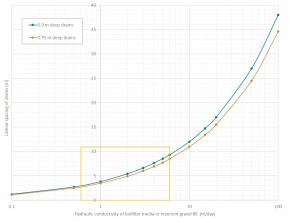Difference between revisions of "Hooghoudt"
Jump to navigation
Jump to search
Jenny Hill (talk | contribs) (Created page with "===Spacing drainage pipes to reduce groundwater mounding=== File:Drain spacing.jpg|thumb|The yellow box represents the recommended hydraulic conductivity of bioretention fil...") |
(No difference)
|
Revision as of 14:32, 13 June 2019
Spacing drainage pipes to reduce groundwater mounding[edit]
In most LID underdrain applications, lateral drains should be spaced between 5 - 6 m apart.
This recommendation is supported by an analysis of Hooghoudt's equation [1][2][3] in relation to loamy or clayey native soils, where Kmedia>>Ksoil, finds the first term of the numerator negligible, so that the original equation: may be simplified to:
Where:
- Kmedia is expressed in m/day
- Dd is the depth to the drain pipe (m)
- Dw is the minimum acceptable depth to the water table during infiltration event
- q is the inflow volume expressed as a depth over the entire surface (m)
- ↑ H.P.Ritzema, 1994, Subsurface flow to drains. Chapter 8 in: H.P.Ritzema (ed.), Drainage Principles and Applications, Publ. 16, pp. 236-304, International Institute for Land Reclamation and Improvement (ILRI), Wageningen, The Netherlands. ISBN 90-70754-33-9
- ↑ W.H. van der Molen en J.Wesseling, 1991. A solution in closed form and a series solution to replace the tables for the thickness of the equivalent layer in Hooghoudt's drain spacing equation. Agricultural Water Management 19, pp.1-16
- ↑ van Beers, W.F.J. 1976, COMPUTING DRAIN SPACINGS: A generalized method with special reference to sensitivity analysis and geo-hydrological investigations, International Institute for Land Reclamation and Improvement (ILRI) Wageningen, The Netherlands


